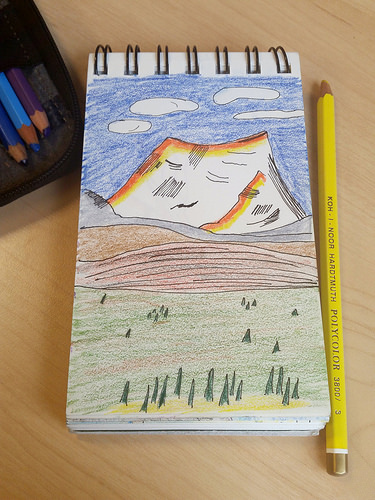
The peak formerly known as Mount McKinley. (All rights reserved)
I just learned that my favorite climbing writer, David Roberts and one of the climbers I admire most, Ed Viesturs, is coming to National Geographic headquarters this spring to talk about their new book, The Will to Climb. Edelweiss gave me my copy for Christmas. I’m pretty excited and am looking forward to going. Also — and perhaps more significantly — Gerlinde Kaltenbrunner will also be presenting on another night! But onto my main topic…
Not too long ago I was amused by a comment from Barbara Washburn — an alpinist and the wife of the late Bradford Washburn — in her book The Accidental Adventurer. She and her husband spent quite a bit of time climbing Mount McKinley/Denali around the 1950s, so she became quite familiar with it in terms of its size, mass and features. Later, when she and her husband made a pilgrimage to take-in Mount Everest, she quickly compared the two peaks and she sounded disappointed by the higher mountain.
While Everest is an impressive three-sided pyramid (in its most basic form), Denali is a mutli-faceted gemstone, with big walls, mini-big walls, numerous hanging glaciers and several knife-edge ridges. It’s complex. Like Barbara Washburn, we recognize Everest’s significance as the world’s highest point and Denali’s as one of the Seven Summits — the “roof” of North America. Both are big destinations, but Denali offers a bigger playground.
It’s also so complex that it has a spectrum of challenging routes established. While the West Buttress (Alaska Grade 2: 50 degrees 13,100 feet) is acknowledged as the most conservative route, Denali’s temptations only start there. To get a sense of the range of challenges, I wondered what were the most difficult routes on the mountain. All but one are on the massive south face:
Cassin Ridge — This route is cliche to some, partly because it was listed in Fifty Classic Climbs of North America. It was listed because it offers all the elements of a great Alaskan climb! It offers 65 degree snow and ice, knife edge exposure and some 5.8 rock. The first ascent by Riccardo Cassin in 1961 pushed he and his team to their limit and it gave them a little frostbite with their glory. The Cassin Route is rated Alaska Grade 5: 5.8 65 degrees.)
Canadian Direct — This route is the newest on this list. Maxime Turgeon and Louis-Philippe “LP” Menard climbed this line in 2006. The line starts up from the Kahiltnak Glacier’s East Fork and up a pillar to the left of the Japanese Direct and right of the American Direct. The ascent is nearly 8,000 feet, and the rock quality reportedly decent (odd for much of Alaska), even though Turgeon reports seeing some rockfall. The route is rated as Alaska Grade 6: M6 5.9.
Slovak Direct — This used to be referred to as the Czech Direct and is the straightest line from base to summit on the mountain. It was first climbed in 1984 by Czecholslovakian alpinists Blazej Adam, Tono Krizo and Franktisek Korl, with the help of a support team on the south buttress. The ascent typically takes several days, and after the first two camps, the rest were mere ice ledges. More recently, the name appears to have been adjusted to reflect the climbers’ proper region and nationality. Interestingly, shortly after the climb, Adam commented that he had done harder routes in Europe. (I think Steve House would disagree.) Slovak Direct is rated Alaska Grade 6: M5 WI6 5.9, 8,500 feet.
Denali Diamond — The route was founded in 1983 by Rolf Graage who felt he had a lot to prove to himself as an alpinist. Graage and guide Bryan Becker climbed for 37 pitches including a 25-foot A3 roof. In 2002, Ian Parnell and Kenton Cool (who sent the first tweet from Everest’s summit, incidentally) did the second ascent in five days — much shorter than the first assault at 17 days. Only a handful of teams have completed the line since because it’s clearly committing and only the experienced or insanely ambitious (I think you can be both) make the attempt. It’s rated Alaska Grade 6: 5.9 A3, 7,800 feet.
Harvard Route — This is — in my assessment — the most dangerous route on the mountain. If the conditions are right, and it’s climbed competently, it might not deserve to be on the list with Slovak Direct and Denali Diamond. But the Harvard Route on Denali has not been repeated. The route is on the north face — on the Wickersham Wall, one of the largest continuous walls in the world. The Harvard Route is unstable. It’s subject to significant rockfall and frequent avalanches. The team that climbed it, from the Harvard Mountaineering Club, climbed in a pleasant state of being naïve to the real dangers. They had never been on a big mountain before and thought the hazards they observed were just all part of the adventure! The route is rated Alaska Grade 4+: 5.5, A1 50 degrees, 14,900 feet.
Thanks again for stopping by. If you enjoyed this post, please consider following The Suburban Mountaineer on Twitter and Facebook.
Sources: 1) Waterman, Jonathan, High Alaska: A Historical Guide to Denali, Mount Foraker and Mount Hunter, AAC Press, 1996; 2) Beckwith, Christian, “Denali Diamond; The New Cassin?” Alpinist July 6, 2007; 3) Turgeon, Maxime, “Mt. Foraker and Denali,” Alpinist, November 27, 2006.
Could you shoot me some info on those presentations? If the cost to get in isn’t too bad, I’d enjoy coming up for those, and I think my dad would enjoy it too.
It’s very reasonably priced, actually! Check the events in Washington, DC on February 13, February 29, and April 16. Plus They have the Banff Mountain Film World Tour coming through too. http://events.nationalgeographic.com/events/locations/center/grosvenor-auditorium/ Enjoy, Ethan!
Brilliant, thanks for that!